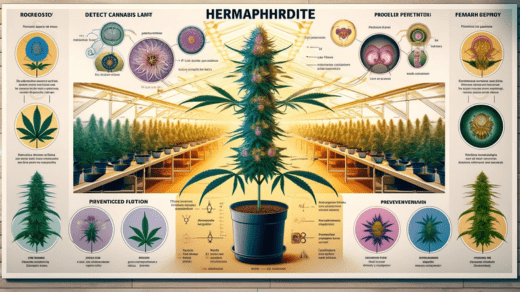Cannabis cultivation is a delicate process that requires careful attention to detail. One of the challenges that growers face is the presence of hermaphrodite cannabis plants. Hermaphroditism refers to the condition where a plant possesses both male and female reproductive organs. While it may seem like a convenient way to ensure pollination, hermaphrodite cannabis plants can actually pose several risks and problems. In this article, we will explore the causes of hermaphroditism in cannabis plants, how to detect them, and, most importantly, how to prevent them from occurring.
Understanding the causes of hermaphroditism in cannabis plants
A variety of factors can cause hermaphroditism in cannabis plants. One of the primary causes is stress. When a cannabis plant is subjected to extreme conditions such as temperature fluctuations, nutrient deficiencies, or physical damage, it may respond by developing both male and female reproductive organs. This is an adaptive mechanism that allows the plant to ensure its survival by self-pollination.
Another common cause of hermaphroditism is genetics. Some cannabis strains are more prone to developing hermaphrodite plants than others. If you are using regular cannabis seeds, there is always a chance that some of them may produce hermaphrodite plants. This is why many growers prefer to use feminized cannabis seeds, which have been selectively bred to eliminate the risk of hermaphroditism.
The risks and problems associated with hermaphrodite cannabis plants
While hermaphroditism may seem like a convenient way to ensure seed production, it can actually have several negative consequences for cannabis growers. One of the main risks is pollination. When a hermaphrodite plant releases pollen, it can pollinate nearby female plants, resulting in the production of seeds. This can significantly reduce the quality and potency of the harvested buds.
Additionally, hermaphrodite plants can also cause problems in a grow room or garden. The pollen released by these plants can spread throughout the area and contaminate other plants. This can lead to a decrease in yield and overall quality of the crop. Moreover, the presence of hermaphrodite plants can make it difficult to maintain a consistent and stable environment for the cultivation of cannabis.
How to detect hermaphrodite cannabis plants
Detecting hermaphrodite cannabis plants is crucial in order to prevent the negative consequences associated with them. The first step in detection is regular and thorough observation of the plants. Look for any signs of male flowers, which typically appear as small, sac-like structures. These flowers will be distinct from the female flowers, which have a more elongated shape with hair-like structures called pistils.
Another way to detect hermaphrodite plants is by examining the plant’s pre-flowers. Pre-flowers are small, undeveloped flowers that appear at the nodes of the plant. In hermaphrodite plants, the pre-flowers may display both male and female characteristics. Look for any signs of pollen sacs or pistils on the pre-flowers.
It is important to note that hermaphroditism can occur at any stage of the plant’s life cycle. Therefore, regular monitoring should be done from the vegetative stage all the way to the flowering stage. By being vigilant and proactive, growers can detect hermaphrodite plants early on and take the necessary steps to prevent pollination and seed production.
Preventing hermaphroditism in cannabis plants
Preventing hermaphroditism in cannabis plants requires a combination of proper care and cultivation techniques. One of the most effective methods is to use feminized cannabis seeds. Feminized seeds have been selectively bred to eliminate the risk of hermaphroditism, ensuring that you will only grow female plants. This significantly reduces the chances of pollination and seed production.
In addition to using feminized seeds, it is important to create a stable and stress-free environment for your cannabis plants. Maintain proper temperature, humidity, and light levels throughout the plant’s life cycle. Avoid excessive physical stress such as overwatering or rough handling. Provide the plants with a well-balanced nutrient regimen to ensure they receive all the necessary elements for healthy growth.
Regularly inspect your plants for signs of stress or any other issues that may trigger hermaphroditism. Address any problems promptly to prevent them from escalating. By maintaining a healthy and stress-free environment, you can significantly reduce the risk of hermaphroditism in your cannabis plants.
The importance of feminized cannabis seeds
Feminized cannabis seeds have revolutionized the way cannabis is grown. These seeds are specifically bred to produce only female plants, eliminating the risk of hermaphroditism. By using feminized seeds, growers can ensure that their crop will consist of high-quality, seedless buds.
Feminized seeds are also a cost-effective solution. Since they eliminate the need to separate male plants, growers can maximize their space and resources. This means increased efficiency and higher yields. Furthermore, feminized seeds offer consistency in terms of genetics. Each plant grown from feminized seeds will have the same characteristics, making it easier to predict and control the outcome of the crop.
Best practices for growing cannabis to prevent hermaphroditism
To prevent hermaphroditism in cannabis plants, it is important to follow some best practices throughout the cultivation process. Firstly, start with high-quality feminized seeds from a reputable source. This will ensure that you are working with genetics that have been specifically bred to eliminate the risk of hermaphroditism.
Next, create a controlled environment for your plants. Maintain optimal temperature and humidity levels, as well as a consistent light cycle. Avoid any sudden changes or extremes that could induce stress in the plants. Provide them with a well-balanced nutrient regimen to promote healthy growth and development.
Regularly inspect your plants for any signs of stress or abnormalities. Look out for any male flowers or pre-flowers displaying both male and female characteristics. If you detect any hermaphrodite plants, remove them immediately to prevent pollination.
Common misconceptions about hermaphrodite cannabis plants
There are several misconceptions regarding hermaphrodite cannabis plants that need to be addressed. One common misconception is that hermaphroditism is solely determined by genetics. While genetics can play a role, stress is also a significant factor. By providing a stable and stress-free environment, growers can greatly reduce the risk of hermaphroditism, even with genetics that are prone to it.
Another misconception is that hermaphrodite plants can be used for seed production. While it is true that hermaphroditism allows for self-pollination and seed production, the resulting seeds are generally of lower quality. They may possess genetic abnormalities and have a higher chance of developing into hermaphrodite plants themselves. For high-quality seeds, it is best to rely on feminized seeds from a trusted seed bank.
How hermaphrodite cannabis plants affect the quality of marijuana, hemp, and weed
Hermaphrodite cannabis plants can have a significant impact on the quality of the final product. When a hermaphrodite plant pollinates a female plant, the production of seeds reduces the overall potency of the buds. This is because the plant’s energy is diverted towards seed production, resulting in lower levels of cannabinoids such as THC.
Furthermore, the presence of seeds can affect the taste and texture of the buds. Seeds can add a harsh, bitter taste to the smoke, diminishing the overall enjoyment of the cannabis. Additionally, the presence of seeds can make it more challenging to process the buds for extraction, as they need to be carefully removed to avoid contamination.
For these reasons, it is crucial to prevent hermaphroditism in cannabis plants to ensure the highest quality of marijuana, hemp, and weed.
Conclusion
Hermaphrodite cannabis plants can pose significant risks and problems for growers. From reduced potency to contamination and lower quality, the negative consequences of hermaphroditism are numerous. However, by understanding the causes and implementing preventive measures, growers can greatly reduce the risk of hermaphroditism in their cannabis plants.
Using feminized cannabis seeds is a reliable way to eliminate the risk of hermaphroditism. Creating a stable and stress-free environment, maintaining proper care and cultivation techniques, and regularly monitoring the plants are essential practices for preventing hermaphroditism.
By following these guidelines and debunking common misconceptions, growers can ensure that their cannabis plants will produce high-quality, seedless buds. With the right approach, cannabis cultivation can be a rewarding and fruitful endeavor.

